Iceland is a dream destination- its raw beauty is jaw-dropping and there is so much to explore for nature lovers, adventure seekers, and even spa junkies! If you’re wondering when is the best time to visit Iceland, we vote for winter. However, there’s not a bad time to visit since each season offers its own treasures. You can’t go wrong with a snowy winter wonderland or a lush green paradise in the spring and summer. We had the pleasure of visiting Iceland in winter and had the time of our lives. Visiting Iceland in March was perfect because it wasn’t too crowded, prices were lower, and it is beautiful! We loved it so much that we know we will be back again. Iceland is on pretty much everyone’s bucket list these days, so here are our best tips for visiting Iceland in winter. Our advice is geared for Iceland winter travel but most of it pertains to a visit any time of the year. We hope our travel tips help you plan an amazing Iceland winter trip!
1.There are several great free apps for visiting Iceland that will help you make the most of your vacation. The Be Iceland App gives you suggestions on just about everything you could need with categories including Eat, Sleep, Discover, Enjoy and Shop. It can help you find interesting places nearby or something as specific as where to buy real Icelandic clothing. The Aurora App gives you the aurora borealis forecast and the best locations for spotting the Northern Lights, a must-see when visiting Iceland in the winter.
2. Drive around to catch a glimpse of the incredible Northern Lights- just get to a dark location away from city lights. Most people sign up for a Northern Lights tour and then ride a bus with tons of other people out to a dark spot where they all stand around in the cold for hours hoping the Northern Lights appear. There is no guarantee to see the aurora borealis on these tours, so many people go home disappointed after shelling out $60 or more. If you rented a car and are comfortable driving on icy and snowy roads, you can just drive to a dark spot outside the city, or find out where the best location is with your Aurora app and save your money. We drove out to Kleifvatn Lake which is between Reykjavik and Keflavik to try to spot the lights (and were standing next to people who paid for a tour to the same spot) but sadly the cloud coverage was too thick and we didn’t spot it during that excursion. That just gives us another reason to visit Iceland again in the winter, as if we needed one. The best season to see the Aurora Borealis is from September to mid-April. This photo below was captured with a cell phone by a friend we made in Vik, who was happy to share it with us. Make sure to bring a tripod and a good DSLR camera to capture the best photos of the Northern Lights, which are not usually so spectacular with a cell phone camera. Set your ISO to at least 800, your aperture as low as it wil go, and keep your shutter speed between 5 and 30 seconds. The aurora borealis is more spectacular seen through a DSLR camera than to the human eye, so don’t get disappointed if it doesn’t look quite as cool as the photos you’ve seen 😉
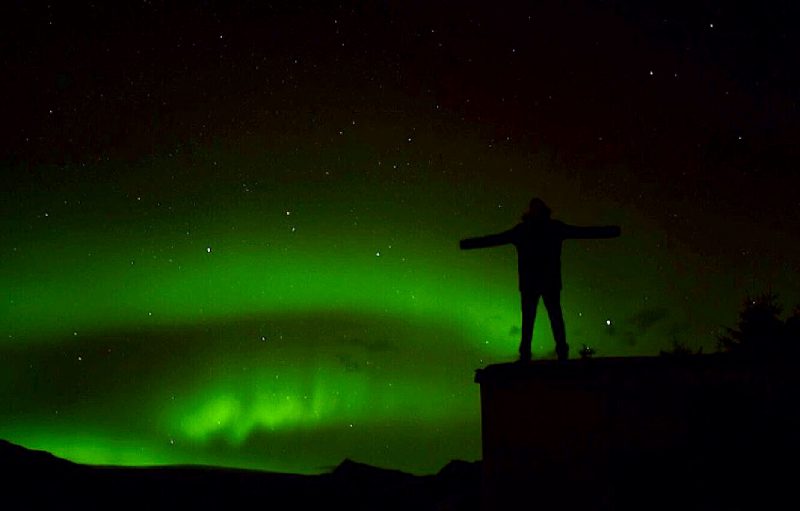
The Northern Lights are a must see in Iceland during winter
3. Rent a 4×4 car if you plan to do any winter road trips in Iceland, which we highly recommend to discover the breathtaking beauty of the country. While we were there we drove through some fierce blizzards with total white outs and saw several cars that went off the road, got stuck in the snow, and had to be towed out. One car was blown off the road by the wind! We were able to drive on the icy and snowy roads and get off the main Ring Road to explore Iceland’s hidden gems, which would not have been possible or safe without a 4×4 vehicle. If you aren’t comfortable driving in snowy conditions, then renting a car in Iceland during the winter is probably not for you. There are several guided tour options that can take you to see the highlights around the country, but we like the flexibility of being on our own schedule. Make sure to stop often to take photos, but don’t stop on the road or you could cause a car accident. This seems like common sense, but believe us, we were behind several cars that just stopped on the road for photos.
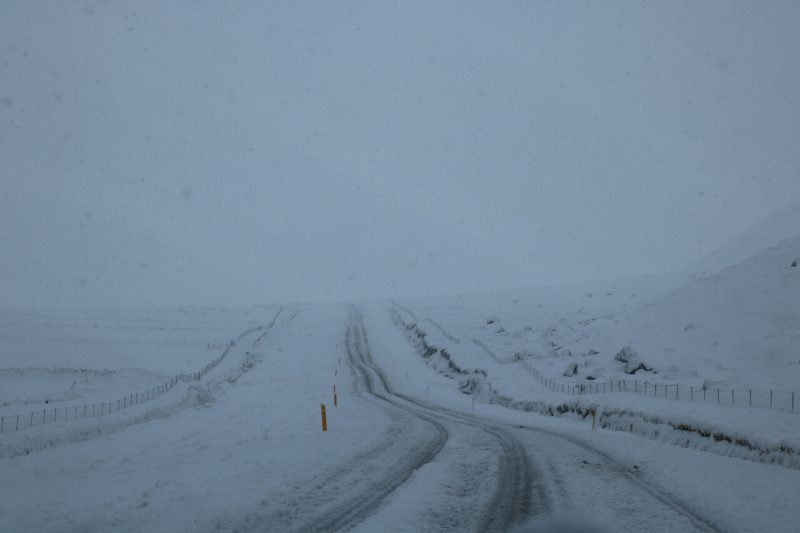
Rent a 4×4 to drive safely on icy snowy roads in Iceland during the winter
4. If you do rent a car, budget a lot of money for gas. Gas cost nearly $8 USD per gallon while we were there, so we spent several hundred dollars on gas alone in the 5 days that we visited. We drove the Golden Circle, out to Kleifvatn Lake twice, to the Blue Lagoon, and then drove from Reykjavik to the Jokulsarlon Glacier Lagoon and back to Keflavik Airport. Combine that with a few hundred dollars for the car rental and it adds up very quickly to road trip around Iceland. However, we think it is worth every dollar! The scenery you pass will blow your mind and the memories you create are priceless!
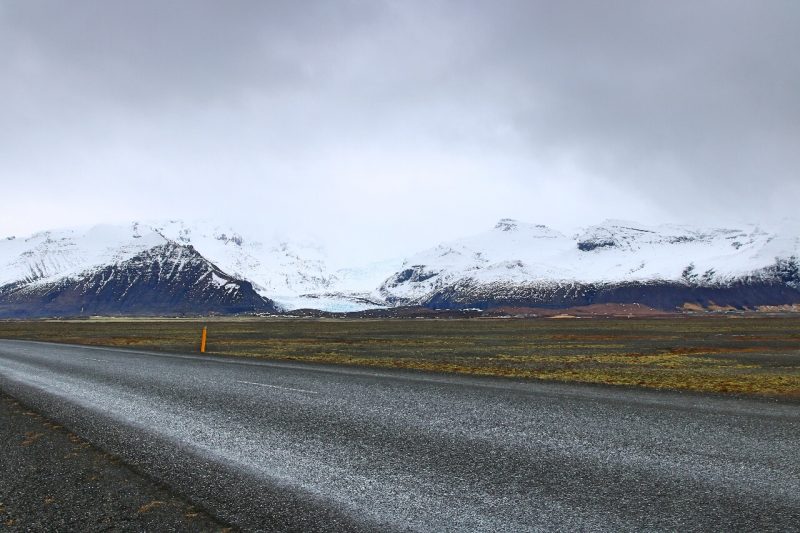
Jaw-dropping scenery like glaciers and mountains makes a winter road trip in Iceland a must-do
5. Check the road and weather conditions before you travel and don’t do any off-roading- it is illegal and damages the vulnerable Icelandic soil and vegetation. Tire tracks can leave marks for decades. Respect Icelandic nature and be very careful. Some helpful websites for safe travels include:
- SafeTravel.is – The Icelandic Association for Search and Rescue
- Vedur.is – Weather forecasts from the Icelandic Meteorological Office
- Road.is – Road conditions
- The 112 App – the Icelandic emergency number app with location based service
Also, there are many single-width bridges throughout Iceland, and the driver closer to the bridge has right of way. It is not always easy to know who is closer, so it is best to slow down before entering these bridges and make sure that no one else is coming from the opposite direction. It’s also good to know that the speed limit is 50km per hour in urban areas, 90km on paved roads outside towns, and 80km on gravel roads. There are speed cameras in some areas so make sure to obey the speed limit.
6. Take a hike to a glacier for one of the most incredible sights you will ever see. You don’t even have to pay any money to see the glaciers, but if you want to take a glacier hike or enter an ice cave, you must take a guided tour. DO NOT walk on a glacier without a certified guide- it’s very dangerous and you may never come back. Several hikers have lost their lives from venturing onto the glaciers without a guide. We recommend the Svinafellsjokull glacier in the Skaftafell National Park, which you can nearly drive up to and take amazing photos. Take the trail up to get an even better perspective, or fly a drone for unbelievable photos and videos! Check out our YouTube channel for video footage we captured with our drone of the gorgeous glaciers in Iceland.
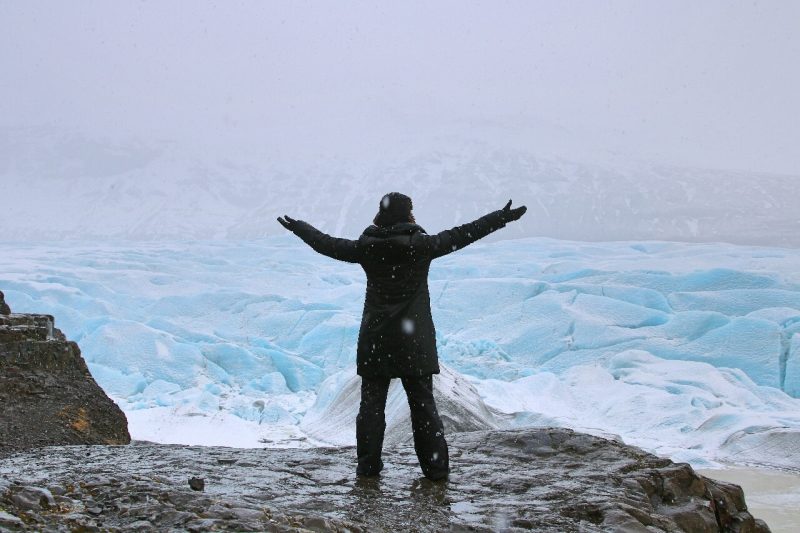
Walk up to the Svinafellsjokull glacier in Iceland for priceless views!
7. Explore the black sand beaches which are incredible to see covered in snow with the huge waves crashing against the beach, but be very careful. Never turn your back on the ocean because the dangerous sneaker waves have taken several lives of tourists who were trying to get the perfect photo and ended up getting pulled into the ocean. We had set our tripod up to take a time lapse video pretty far away from the ocean and a sneaker wave hit sending water up over the base of our tripod, which thankfully did not fall over or get washed out to the ocean. We had to run quickly up the beach a few times to avoid getting wet from sneaker waves that sent water up the beach much farther than the normal waves.
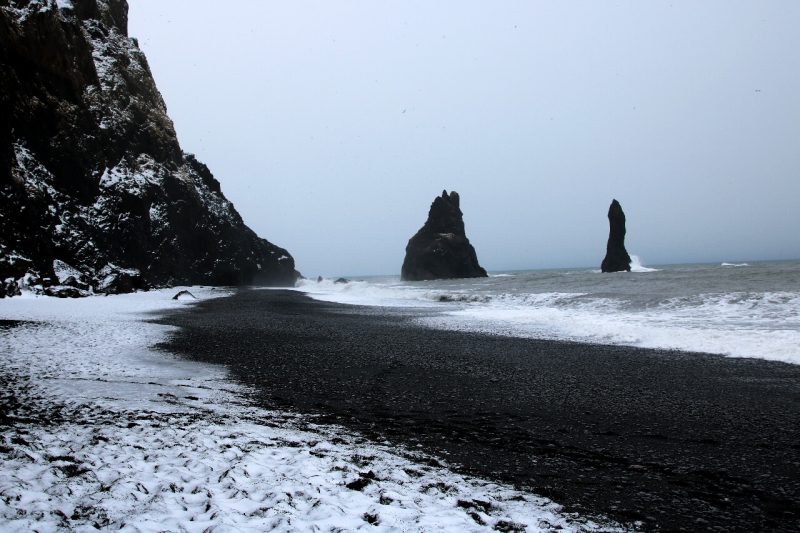
Reynisfjara Black Sand Beach just before Vik with freshly fallen snow
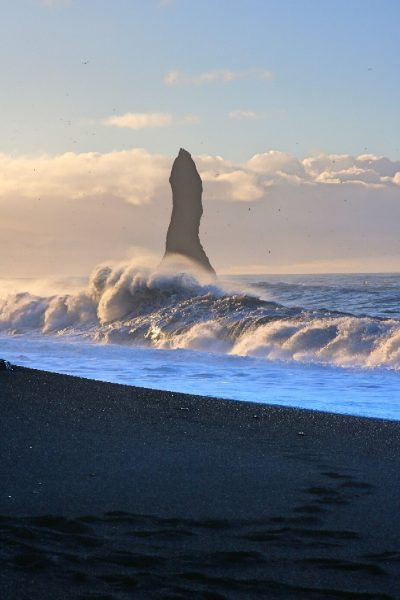
Watch out for deadly sneaker waves on the beaches in Iceland!
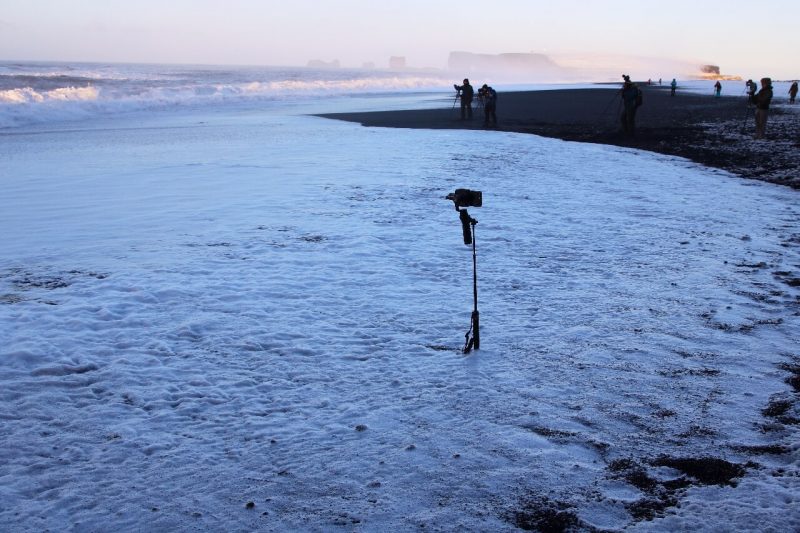
Our tripod getting surprised by a sneaker wave at the black sand beach
8. Dress in layers for quickly changing weather conditions. Waterproof boots, pants, and coats are necessary since it can switch from sunny to snowing to raining in a matter of minutes. They say that if you don’t like the weather in Iceland, wait 5 minutes. This is so true. You could buy an Icelandic wool sweater for a souvenir that will keep you very warm during your vacation, but it will set you back at least $150-200. We wore several layers including insulated underwear, warm sweaters, thick socks, and heavy windproof and waterproof coats and ski bibs. We also rocked the Russian-style hats to keep our heads toasty, warm scarves and of course weatherproof gloves. Don’t forget hand and foot warmers too! Basically, whatever you would wear to go skiing is what you want to wear when exploring Iceland in the winter. It is really cold and windy! It’s the perfect snow for making a snowman though!
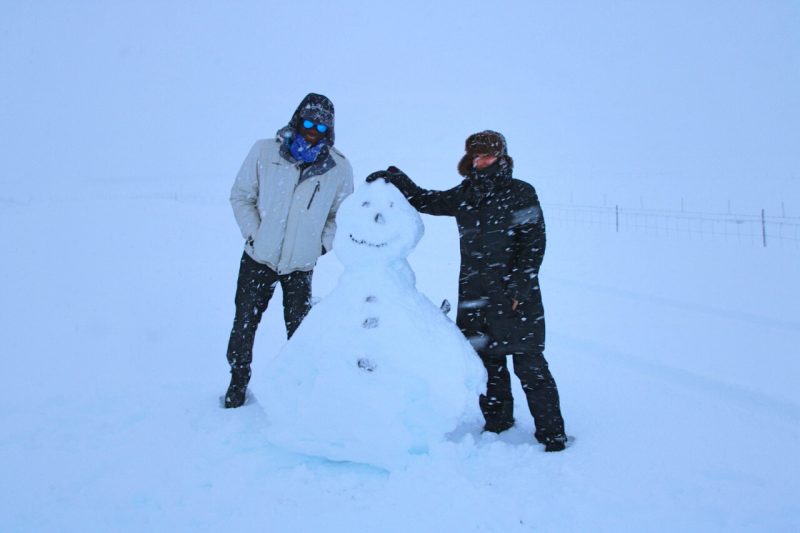
All bundled up with lots of layers for the snowy cold winter in Iceland
9. Bring a lot of snacks from home to save money because food is extremely expensive. We brought some bags of nuts, cereal bars and granola bars but next time will bring even more food. Don’t forget a reusable water bottle too since the water in Iceland is so clean that you can drink water straight from the glaciers. Shop at the grocery stores and stay in Airbnb’s with kitchens if you want to save even more money by eating in some of the time or packing sandwiches for your road trips. We wanted to try traditional Icelandic food so ate out for one meal every day and then ate food from the grocery store for the other 2 meals. Just to give you an idea of how expensive restaurants are, we paid $26 for a bowl of lobster soup at Lava Restaurant at the Blue Lagoon. It was more for the experience and beautiful ambience overlooking the blue lagoon, but we couldn’t get over how ridiculous the restaurant prices are in Iceland. Nonetheless, we always want to taste the local food when visiting a new place. We encourage you to save up and visit some restaurants while you are there. Some things you should try are Icelandic lamb, meat soup, fresh fish, and Icelandic sausages which are the cheapest option (can be found for $4). Brave people can also try the fermented rotting shark meat and boiled sheep heads, which we did not have the pleasure of tasting this visit.
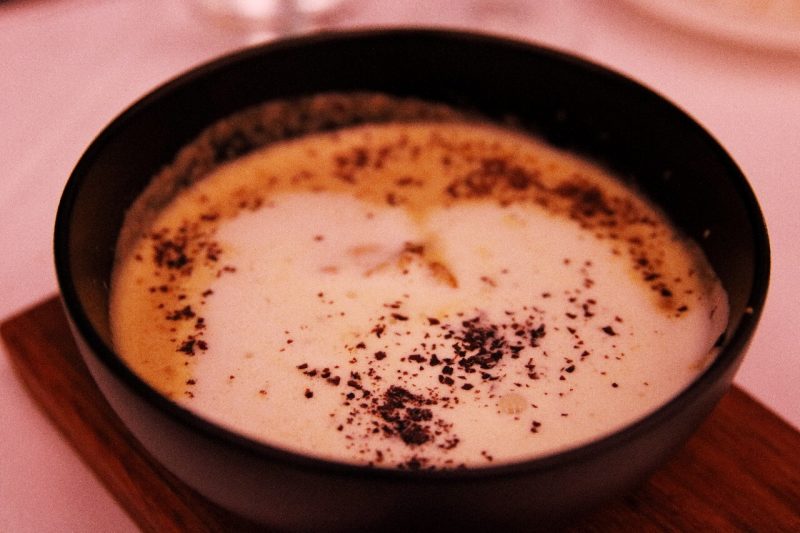
Here’s what $26 will buy you in an Icelandic restaurant- a small bowl of soup with one chunk of lobster in it!
10. Don’t drink alcohol in Iceland, or go to a happy hour for half price drinks. We usually enjoy wine with dinner, especially while on vacation, but in Iceland we only drank once because alcohol is so darn expensive. A glass of house wine costs about $15 and a draft beer about $9. We splurged on prosecco at the Blue Lagoon because it’s not every day that you soak in a thermal spring in the middle of winter. If you want to buy alcohol drink at your hotel or Airbnb you can only purchase alcohol from liquor stores, which close very early. We were told they close around 4 or 5pm on the weekends and 6pm during the week, so we never made it to one on time. Plan accordingly if you want to buy alcohol from a liquor store, which I presume is less expensive than the restaurants, or just skip it altogether and save your money.
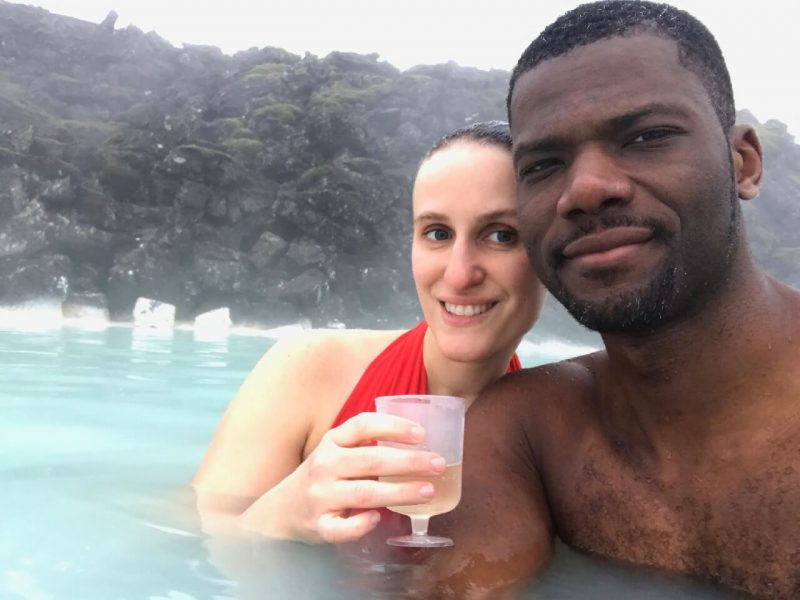
Enjoying a glass of prosecco at the Blue Lagoon- the only alcohol we drank in Iceland due to the high prices
11. If you lose anything, call 354-444-1000 which is the Reykjavik lost and found. You can also stop by the local police station which is where the lost and found offices are located. They are only open weekdays during limited business hours so try not to lose anything during the weekend. 😉 I lost my iPhone 7 while driving around looking for the Northern Lights and thankfully an honest person turned it in (unfortunately after I left the country). I sent an email to the lost and found and a few days after coming home I received a message that my phone had been turned in. Icelanders are so kind that they are going to mail it to me (I’m still waiting to hear how much that’s going to cost, but it will be a lot less than $850 to replace my phone). They even have a Pinterest page that shows photos of all the found items, which made me feel a little better that there were tons of lost cell phones just in the week that we were there. If you find yourself in this position, you can also send an email to lostandfound@lhr.is with a description of your lost item and how they can contact you. How helpful is that!
12. Last but not least, don’t leave the country without soaking in a natural hot spring or lagoon! There’s something so magical about soaking in hot thermal water while snowflakes fall on your head. We opted for the Blue Lagoon because that milky blue mineral-enriched water is something we had to experience for ourselves, and despite being expensive ($50 is the cheapest option) and touristy, it was absolutely worth it! It has been named one of the 25 wonders of the world and it is incredible. Yes it is crowded but you can find spots to be alone if you wander out to the edges. This was one of my favorite things to do in Iceland because it was so relaxing, romantic, and just really freaking cool! In fact Iceland’s Blue Lagoon has become the most popular bucket list travel experience among millennials, and we completely understand why. For a cheaper option the Secret Lagoon is half the price and is more secluded so you can actually watch for the Northern Lights while soaking in the hot steamy water. That sounds like perfection to me. The Myvatn nature bath is another good option in the north which costs about $35. A budget-friendly option is the completely natural hveragerdi hot spring that is free if you are willing to hike an hour through the snow to find it. We heard about this one from some locals but you might not be able to find it unless someone who’s been takes you there. We want to try that one next time! It is near the town of Selfoss. Happy hot spring hunting!
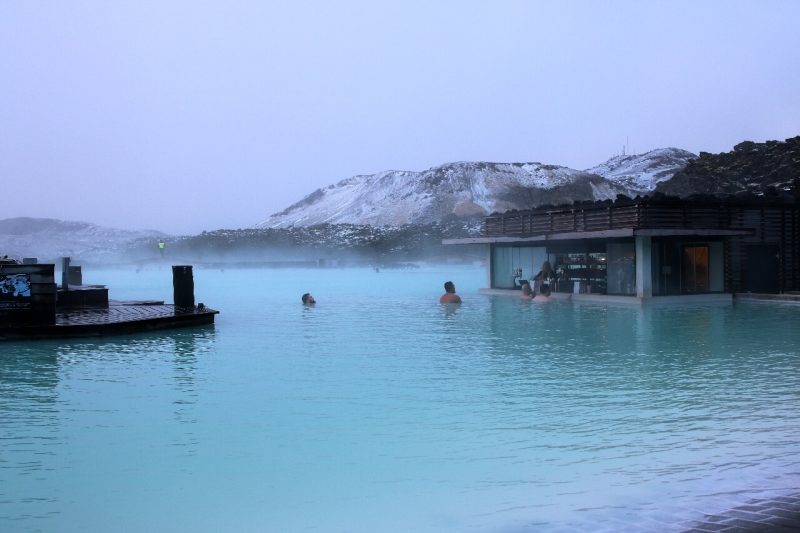
Mountain views, milky blue water and a swim up bar make the Blue Lagoon an unforgettable and must-do experience in Iceland
Have we inspired you to visit Iceland during the winter? Summer used to be the main time tourists visited Iceland, but now the winter is seeing more visitors due to the dramatic landscapes that look so amazing during the winter. Plus, there are really cool things like ice cave tours and snowmobiling that you can only do during the winter. We cannot recommend a winter visit to Iceland enough! Just remember to dress warm and follow the safety guidelines because you don’t want to mess with powerful Mother Nature in Iceland. For more tips for visiting Iceland, check out our top attractions in South Iceland, how to spend a day in Reykjavik, and breathtaking drone shots of Iceland. You can also read this 4 day itinerary for Iceland from Sea of Blush travel blog. What is your favorite winter destination? If you liked this post, please sign up for our email newsletter to receive weekly travel tips and inspiration to explore the world. Please share this post with whoever you think would also love to visit Iceland, and honestly, who doesn’t want to?
Pin this post:

12 Tips for Visiting Iceland in Winter


3 comments
Omg you guys this is an amazing post!!!! I agree 100%!
Thanks Victoria! Iceland is so stunning! Thanks for your tips as well!! 😉
[…] I really recommend that you choose Iceland solo female travel. You might also like to read about Visiting Iceland in the Winter and Iceland 9 Day Ring Road […]
Comments are closed.